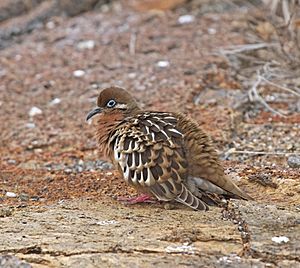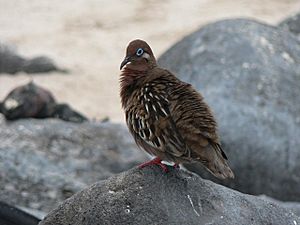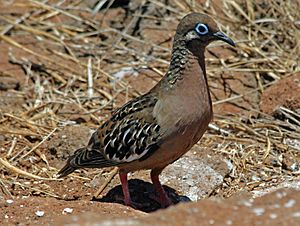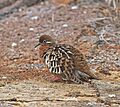Galápagos dove facts for kids
Quick facts for kids Galápagos dove |
|
|---|---|
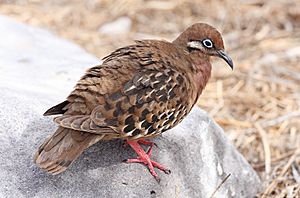 |
|
| Española, Galápagos | |
| Conservation status | |
| Scientific classification | |
| Genus: |
Zenaida
|
| Species: |
galapagoensis
|
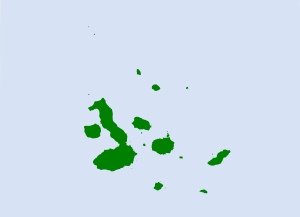 |
|
The Galápagos dove (Zenaida galapagoensis) is a special type of bird that lives only on the Galápagos Islands, off the coast of Ecuador. It is a common bird found in open areas and places with some trees and bushes, especially in the dry, low parts of the islands.
Contents
Types of Galápagos Doves
There are two main types, or subspecies, of the Galápagos dove:
- Zenaida galapagoensis galapagoensis (Gould, 1839) – This is the most common type. You can find it on most of the big Galápagos islands, except for Darwin Island and Wolf Island.
- Zenaida galapagoensis exsul (Swarth, 1931) – This type is a bit bigger and darker. It lives only on Darwin Island and Wolf Island.
Even though these doves live on different islands, they often fly between them. This helps keep the different groups of doves quite similar. Their strong flight skills mean they don't change as much from island to island as some other Galápagos animals, like the Galapagos hawk or the Darwin's finches. It's also possible that eating many different kinds of food helps them stay similar.
What the Galápagos Dove Looks Like
The Galápagos dove is about 18–23 cm (7.1–9.1 in) long and weighs about 67–92 g (2.4–3.2 oz). It has a long, black beak that curves slightly downwards. Its feet and legs are reddish with a hint of purple.
This dove has a striking appearance. Its upper body is dark reddish-brown. Its neck and chest are pinkish, and its belly is buff-colored. The wings are brown with white and black stripes. The skin around its eye is deep blue with a black edge, and its eye is brown. You can see a shiny, colorful patch on the side of its neck. The feathers on its back and wings are black with a white stripe down the middle, making the wings look streaked. The feathers under its wings are grey to blue. Its central tail feathers are brown, and the outer ones are grey.
Female doves look a lot like males, but they are usually smaller. Their colorful neck patch is also smaller, and their back, wings, and tail are darker.
Where They Live
Galápagos doves live in rocky lowlands. They can be found among scattered trees, bushes, and cacti.
Behavior and Life
Reproduction and Nesting
When a Galápagos dove's nest is in danger, the parents will pretend to be hurt. They do this to trick predators and lead them away from their eggs or young. Most Galápagos dove nests are built on the ground. They are often hidden under lava overhangs or in old mockingbird nests found in cacti.
A female dove usually lays two eggs at a time. Breeding starts about three to five weeks after the wet season begins. They can have up to three groups of chicks each year.
Feeding Habits
The Galápagos dove's long, curved beak helps it find food on the ground. They mostly eat seeds and fruits. These doves do not like to fly and will only do so if they really have to. They spend most of their time on the ground looking for food. Their diet mainly includes seeds, caterpillars, and the flowers and pulp from Opuntia cacti.
On islands where there are no bees, the Opuntia cacti have softer spines. This might make it easier for birds, including the doves, to reach the flowers. When the birds visit the flowers, they help spread pollen, which helps the cacti reproduce.
Doves usually crush seeds before eating them. However, some seeds are swallowed whole. Some of these seeds survive digestion and are later spread by the bird. This helps new plants grow in different parts of the Galápagos.
Staying Safe
Because Galápagos doves live only on these islands, they are at risk from new diseases and animals brought by humans. Some diseases, like Trichomonas gallinae (which might come from mainland doves) and Haemoproteus malaria, have been found in them. Another threat is Chlamydia psittaci. These diseases can also spread from the doves to other animals in the Galápagos, like Galapagos hawks, if the hawks eat the doves.
Galápagos Doves and Humans
The Galápagos dove shows how animals can change when humans interact with them. The first time British sailors met these doves was in 1685. Like many animals in the Galápagos, these doves were very tame. They showed no fear and would come in large groups, even sitting on the sailors' heads and shoulders. This made them easy to hunt. However, over time, the doves learned to avoid people and became less tame.
Conservation Status
In the 1600s, sailors started hunting Galápagos doves. This hunting continued until at least the 1960s. Today, the biggest threat to these doves comes from wild cats that have been brought to the islands. Other dangers include diseases, pollution, and changes to their natural home.
Images for kids
See also
 In Spanish: Tórtola de las Galápagos para niños
In Spanish: Tórtola de las Galápagos para niños



